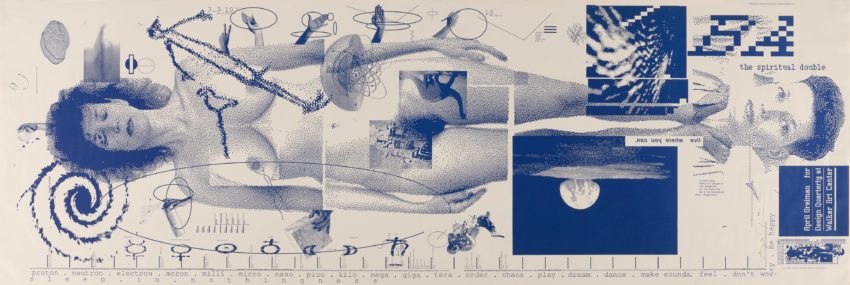Corey Rossi
IXD History
Fall 2020

April Greiman, born September 10th, 1948 in New York City, is an American contemporary graphic designer based in Los Angeles, California.2 She is currently the Director of her own design firm known as, Made in Space.1 Made in Space isn’t just any design firm, they implement a multi-disciplinary approach, which is to have specialist in varying fields working together on design projects.2 This innovative practice came from April’s collective experiences throughout her career.
April Greiman attended Kansas City Art Institute from 1966-1970 where she was introduced to the principles of Modernism by her professors Inge Druckrey, Hans Allemann, and Chris Zelinksy.4 Her deep-dive into this field would have such a profound impact on Greiman that she decided to attend the Basel School of Design in Switzerland, where all her teachers had attended as well. It was at this school April worked rigorously under Admin Hoffman and Wolfgang Weingart.4 She studied the International Style as well as Wolfgangs personal experiments in developing a new aesthetic.
This aesthetic is now what we call, New Wave. This new method to address design looked at grids differently by utilizing wide letter spacing, changing type weights and styles within a single word, and the use of type set on an angle.2 The pre-work in developing the New Wave style was to think of design as a place to try new things, with intent and effort, that are communicative but still artful.4 Wolfgang wanted to, “expand the typographic communication in a meaningful way”4 and April resonated with that goal.
Eventually April Greiman would take the idea of “communication in a meaningful way” to Los Angeles and be one of the first people to introduce New Wave into the US.2 Around this time the new it-girl of computers, the Macintosh, was released. April was no stranger to technology and embraced this new computer as a tool for design.3 During this time many graphic designers were sour towards computers as design tools. They believed computers would compromise the International Style.2 However, April saw more than that.
Using computers and new technology, Greiman explored typographic meanings and experimented with ways to combine 2D, 3D, and even 4D, bringing an entirely new perspective into Graphic design.4 She believed, that as the world changes and technology evolves so does the field of graphic design. Luckily April doesn’t fall short of examples for this work. One piece titled, Design Quarterly 133, “Does it Make Sense?” Was April’s way of presenting her digital work that was heavily critiqued and was a technical feat in that her work was almost too process heavy for computers at the time.4
April Greiman’s innovations in design and her beliefs to embrace technology as design tools is revolutionary to the Interaction Design field. While working as a professor at the California Institute of the Arts, April renamed her department from “Graphic Design” to “Visual Communication” to address the limitations the term Graphic Design would bring to future designers.2 “It’s not just graphic design anymore. We just don’t have a new name for it yet.”4 The choices she made early in her career influenced the multi-faceted field that we call interaction design today.

Stepping into the light and facing her male counterparts did not stop April from making strides in the field of design. Her ability to embrace technology allowed her to develop the field to where we are now, and instead of being afraid she innovated.

Works Cited:
1 “About.” Madeinspace, www.madeinspace.la/about.
2 “April Greiman: Biography, Designs and Facts.” Famous Graphic Designers, www.famousgraphicdesigners.org/april-greiman.
3 “April Greiman.” Design Lecture Series, designlectur.es/events/april-greiman/.
4 Biography by Steven Heller September 1. “April Greiman.” AIGA, www.aiga.org/medalist-aprilgreiman.
5 “Poster, California Institute of the Arts, 1978.” Cooper Hewitt, Smithsonian Design Museum, collection.cooperhewitt.org/objects/18617589/.
